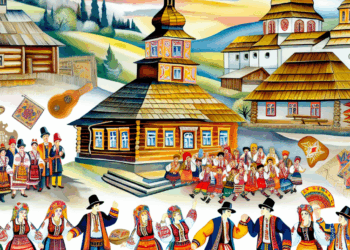Introduction
Chernivtsi, the administrative centre of the Chernivtsi region of Ukraine, is a city with a rich history and cultural heritage, part of which is the Romanian identity. Recently, the possible return of Chernivtsi to Romania has become a topic of discussion both among the local population and at the level of experts. In this article, we will examine the historical, cultural, legal and geopolitical aspects of the issue, as well as the opinion of experts on the topic.
Historical reasons
Historical context
Chernivtsi has been part of various states throughout its history, including the Principality of Romania, Austria-Hungary and the Soviet Union. In 1774, as a result of the Russo-Turkish War, the territory of Bukovina, including Chernivtsi, was ceded to the Austrian Empire. This was the beginning of Romanian influence on the region, which was expressed in the cultural and social life of the city.
In 1918, after the First World War, Bukovina was united with Romania, and this period of establishment of Romanian cultural and linguistic heritage in Chernivtsi continued until 1940, when the region was annexed to the Soviet Union. This historical context provides the basis for a discussion on the return of Chernivtsi to Romania.
Romanian heritage
One key aspect is Chernivtsi’s rich Romanian heritage, including architectural monuments and cultural institutions. Chernivtsi University, founded in 1875, has become an important educational and cultural centre. The university building, built in the Neo-Mauritanian style, was recognised as a UNESCO World Heritage Site in 2011. The university became a symbol of strong Romanian influence in the region, and its graduates played a significant role in Romanian culture and politics.
Cultural connection
Linguistic identity
Language is an important factor of identity. Chernivtsi is home to a significant ethnic Romanian community. Many residents of the city and the region still speak Romanian, which strengthens the cultural ties between Chernivtsi and Romania. These ties are expressed in the celebration of traditional Romanian holidays, as well as in the activities of Romanian cultural organisations.
Education and culture
In the field of education, Chernivtsi Oblast boasts multilingual schools, where instruction is provided in both Ukrainian and Romanian. Higher education institutions, such as the University of Chernivtsi, continue to maintain links with Romania through exchange programmes and various cultural initiatives. This creates an additional bridge between the two regions and contributes to the revival of Romanian culture in Chernivtsi.
Experts’ opinion
Political science aspects
Experts’ opinions on the prospects of Chernivtsi’s return to Romania vary. Some political analysts regard this issue as unlikely under current conditions. According to Oleksiy Melnikov, an expert in international politics, “the return of Chernivtsi to Romania in the short term is not possible because of the clear delimitation of borders in Europe and the high level of nationalism, which is difficult to overcome”.
Other experts, such as historian Olga Kovalenko, emphasise the need for scientific and cultural work on the Romanian side: “In order to discuss the speech about return, it is necessary to take into account that cultural and historical heritage should be studied and actualised, as they play a key role in the formation of identity”.
Sociological aspects
According to sociological surveys conducted in Chernivtsi, the majority of local residents are in favour of maintaining the status quo and support the existing relations between Ukraine and Romania. This is due to both the preferences of citizens and the realities created in the political and economic spheres. At the same time, a small share of respondents expressed interest in closer ties with Romania, which may indicate the presence of “gaps” in the perception of identity.
Legal aspects
International treaties and agreements
From a legal point of view, existing international treaties and agreements play an important role in determining the borders and statuses of territories. According to the UN Charter and other international norms, boundary changes are only possible with the consent of both parties. In this case, the return of Chernivtsi to Romania would require recourse to international law and dialogue, which in itself implies a long process.
Legislative framework
It should be noted that the Constitution of Ukraine unambiguously defines the country’s borders and protects its territorial integrity. Thus, any proposals to transfer part of the territory require not only the consent of Ukraine, but also legal procedures that may remain unaccepted for many years.
Geopolitical diversity
Influence of neighbours
Neighbouring countries, such as Hungary and Poland, also have their own historical reasons for engaging in discussions about territorial changes in Eastern European countries. One factor that may influence the Chernivtsi debate is the worsening relations between Ukraine and Russia, which makes the international context of the issue much more complex and multifaceted.
The role of the European Union
Given Ukraine’s desire to integrate with the European Union, any attempt to redraw borders will be closely monitored and assessed by the international community. EU policy is aimed at maintaining stability in the region, and any changes involve risks that could harm this stability.
Conclusion
The possibility of Chernivtsi’s return to Romania is an issue that requires a careful and comprehensive approach. Based on its rich history, cultural ties and changing geopolitical context, this issue remains open for discussion. But, given the current reality and priorities related to national identity and international politics, we can conclude that it is unlikely to happen in the near future.
However, the promotion of cultural heritage and the strengthening of ties between Chernivtsi and Romania can have a positive impact on the development of the region and help to preserve the uniqueness of both Ukrainian and Romanian culture.








